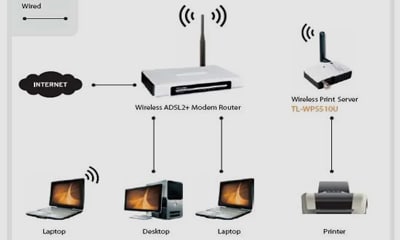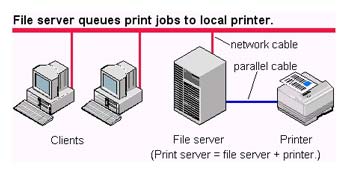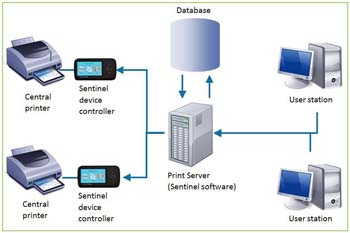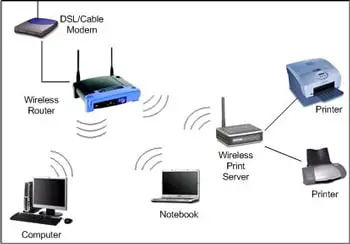
When we use printers at home or in the office, we seldom think about how it is accessing our computer files so easily.
Well, the missing piece of this puzzle is usually a print server. These devices or software programs are designed to establish a stable connection between your computer and the printer.
However, maintaining this connection is not the only job a print server carries out. In this article, we’ll discuss what is a print server and how does it work? Keep reading to know more about these humble intermediary devices!
What Is A Print Server?

A print server in computer networking refers to the kind of server used for establishing a connection between printers and computers within the same network. To put it simply, it is the server with which you access the printer through your computer.
Because of these servers, each client computer like yours can start giving printing jobs to the printer and let it access the files within your device. This is how your team members share the same printer to materialize their necessary documents and boost everyone’s productivity simultaneously.
It is not always a physical server. In addition to network devices, a software application or a computer can also act as the print server. We discuss it in further detail in our article about lists of good USB & Wireless print servers.
How Does A Print Server Work?

A print server is the middleman you need between your computer and the printer.
In order to do its job, the first step that needs to be taken is establishing a connection to both the printer and the client computers. To accomplish this objective, all of these devices and software programs need to be in the same network.
Now, any of the computers can send a printing job to this connected print server. The server then receives all these print requests from different computers and forms the queue for the printer.
It also has the responsibility of directing each job to the specified printer, if there are multiple printers available in the network.
Along with queueing the jobs locally, the server can reorder them or delete a few from the queue if necessary. So it supervises the overall management of the queued jobs.
Ultimately, their workflow looks like this:
- Establish connection to client computers on the same network
- Accepts printing jobs from computers
- Sends the printing job to the right printer
- Queues the jobs locally
- Reorder or delete queued printing jobs
Read More: Do You Need a Good Computer for 3D Printing? Can you use your regular PC or laptop? Learn all about 3D printing computers here!
How Does A Print Server Connect To The Printers?

There are several ways you can establish the connection between a print server and a printer. The servers are built with one or more ports so that if one connection becomes unavailable, you can rely on the next one to continue working with the printer.
1. Ethernet
Ethernet has been the primary source of connections for network devices for a long time. So it comes as no surprise that the printer servers also take advantage of this common connectivity solution.
Besides, this port can also connect to the router directly and make internet access easy for the devices.
2. USB
USB ports are the most common choice of connectivity you will find in print servers. The devices come prepared with a USB port so that you can immediately establish the connection with the printer’s USB port using a cable.
Some routers can also perform as USB print servers by connecting their designated port with the printer.
3. Wi-Fi
If you don’t want to deal with the hassle of cables, you can opt for a wireless print server. They can just connect themselves to the Wi-Fi network where all the client computers and the printers are already available. Utilizing this hassle-free method, workplaces manage to minimize cluttering across the office space.
Advantages Of Having A Print Server
Along with making the printer accessible to all your team members simultaneously, a print server can also help with a number of administrative tasks in the office and provide more conveniences to the employees!
Easier Administration
If there is a print server in your workplace, the new print job requests will not go directly to the printer. They will first be received by the print server which will then form a queue.
This makes it easier for the system administrator in your office to manage the printing resources better and update printer settings as needed.
Some of the common useful management tactics a print server can help with are setting up color printing quotas, checking user authentication and watermarking the printed documents.
Steps like this ensure a higher level of security for all the employees, as well as the official documents handled by the printer.
Show Print Job Status To Users
During office hours, we often need to print out documents within a tight schedule. In these common scenarios, it really helps if our computer can show us how much of the printing job has been completed and how long we might have to wait for the rest to be over.
A print server makes this possible by showing the print job status to the user who initiated that task. You can see how many pages have been printed out and the total number of pages to be printed from the respective software.
Higher Cost-Effectiveness And Productivity
Having a wireless print server can ensure higher cost-effectiveness for your business since you can work with fewer devices for the same output.
A single server like this can make all the employees work with one printer without overlapping their tasks. Besides, it manages the queued jobs so that any of them can be pushed back, pushed front or deleted entirely. This simplifies the whole process and keeps everyone’s productivity in motion throughout the year.
Final Word
As you can see, a print server can get a lot done for your entire team and business. Along with allowing all of you to access the printer for different purposes, this server can also manage the printing queue, keep the members updated about their print jobs and maintain administrative regulations.
Be it a wireless print server or a USB print server, either of them can achieve a higher level of productivity and cost-effectiveness for your endeavors.
Related article that you may like: